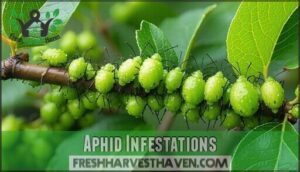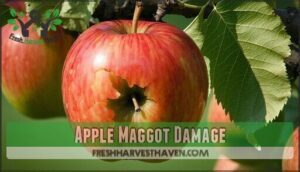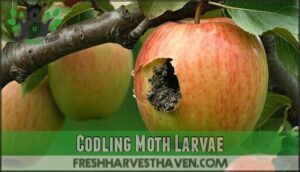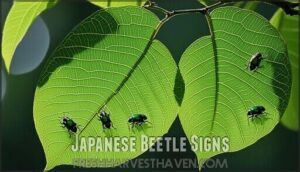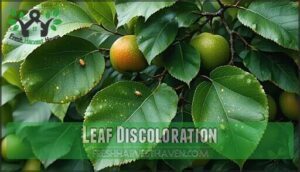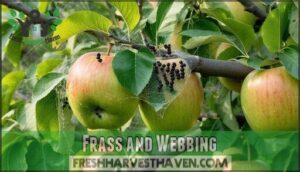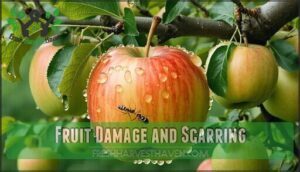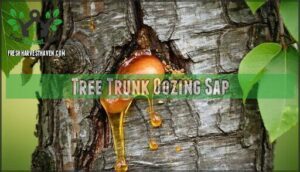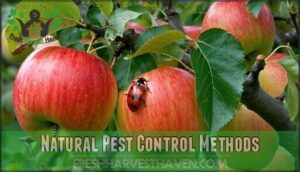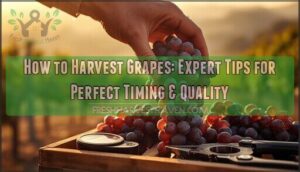This site is supported by our readers. We may earn a commission, at no cost to you, if you purchase through links.
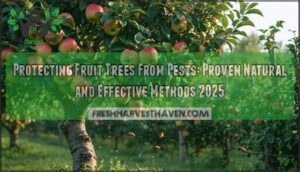
Start by choosing disease-resistant varieties and maintaining proper spacing for good airflow. Regular pruning and weekly inspections help you catch problems early—think of it as your tree’s health checkup.
Natural methods like neem oil, insecticidal soap, and beneficial insects work wonders without harsh chemicals.
Physical barriers such as copper bands around trunks deter crawling pests, while pheromone traps catch flying ones.
Good sanitation practices, including removing fallen fruit and debris, eliminate pest breeding grounds. The secret lies in understanding pest life cycles and timing your interventions perfectly to ensure the health of your fruit trees.
Table Of Contents
- Key Takeaways
- Identifying Fruit Tree Pests
- Signs of Pest Infestation
- Preventing Pest Infestations
- Natural Pest Control Methods
- Managing Pest Infestations
- Frequently Asked Questions (FAQs)
- What is the best pest control for fruit trees?
- What is the best thing to spray on fruit trees?
- What soil conditions help prevent pest problems?
- How often should fruit trees be inspected?
- When is the best time to spray?
- Can overwatering increase pest attraction rates?
- Which fertilizers reduce pest susceptibility naturally?
- How often should fruit trees be inspected for pests?
- What time of year do most pests attack?
- Do fruit tree pests spread to vegetables?
- Conclusion
Key Takeaways
- Start with prevention – Choose disease-resistant varieties, maintain proper spacing for airflow, and prune regularly to create an environment where pests cannot thrive
- Monitor weekly during growing season – Early detection through regular inspections lets you catch problems before they become major infestations that damage your harvest
- Use natural controls first – Neem oil, insecticidal soap, beneficial insects, and physical barriers like copper bands effectively manage pests without harsh chemicals
- Practice good sanitation – Remove fallen fruit and debris weekly to eliminate pest breeding grounds and break their life cycles before next season
Identifying Fruit Tree Pests
You’ll need to recognize specific pests before you can protect your fruit trees effectively.
Learning to identify common invaders like aphids, apple maggots, codling moths, and Japanese beetles helps you catch problems early and choose the right treatment approach.
Common Fruit Tree Pests
Small enemies pack big punches when targeting your fruit trees.
Tiny invaders can destroy entire harvests before you even notice they’ve arrived.
With over 75 species attacking fruit trees globally, proper pest identification becomes your first defense against crop damage.
These common culprits will likely visit your orchard:
- Aphids – Tiny green or black insects clustering on new growth, causing leaf curl and stunted development
- Codling moths – Their larvae bore into fruit, creating wormy apples with characteristic entry holes and frass
- Apple maggots – Adult flies lay eggs inside developing fruit, producing brown tunnels through flesh
- Japanese beetles – Metallic green pests with bronze wings that completely skeletonize leaves during summer feeding
- Spider mites – Nearly microscopic creatures creating fine webbing while draining plant cells
Each pest species follows distinct lifecycle patterns and targets specific fruit tree varieties.
Apple maggots damage up to 50% of unsprayed crops during high-incidence years, while codling moth larvae cause 60-80% losses in unmanaged orchards.
Understanding these fruit tree insects and recognizing early pest symptoms allows you to time interventions effectively, transforming potential disasters into manageable challenges through targeted control methods.
Aphid Infestations
These tiny green invaders cluster on fresh shoots and tender leaves, forming colonies that can devastate your fruit trees.
Silent invaders strike fast—catching aphid armies early saves your entire harvest.
Aphids feed by piercing plant tissue and extracting sap, which leads to leaf curl and stunted growth throughout the growing season.
The sticky aphid honeydew they excrete creates perfect conditions for sooty mold development and attracts armies of ants to your trees.
You’ll find these pests congregating on leaf undersides and new growth, where they reproduce rapidly in warm weather.
| Identification Features | Damage Indicators | Control Signs |
|---|---|---|
| 1-4mm green/black insects | Curled, yellowing leaves | Ladybugs present |
| Dense colonies on shoots | Sticky pest honeydew coating | Water spray effectiveness |
| Wingless and winged forms | Stunted branch development | Reduced ant activity |
Natural predators like ladybugs and lacewings provide excellent aphid control, while strong water jets can dislodge established colonies effectively.
Apple Maggot Damage
Recognizing apple maggot damage saves your harvest from these destructive pest maggots.
Apple maggots create tunneling fruit flesh with distinctive maggot fruit trails and pitted apple areas throughout infected fruit.
Understanding the maggot life cycle helps identify pest damage before ruined harvests occur.
Watch for these warning signs:
- Small entry holes with dark frass nearby on fruit surfaces
- Brown, winding pest tunneling larvae tracks inside apples
- Pest pitted fruits with soft, decaying spots around entry points
- Premature fruit drop from heavily infested trees
- Adult flies hovering near developing fruit during summer months
Codling Moth Larvae
Among fruit tree pests, codling moth larvae create the most distinctive damage patterns that you’ll encounter in your orchard.
These destructive insects bore directly into developing apples and pears, creating unmistakable signs of their presence.
- Larval Burrowing – Larvae tunnel through fruit flesh, creating brown trails and premature fruit drop that signals active infestation
- Frass Identification – Dark, granular waste deposits accumulate near entry holes, providing clear evidence of pest activity inside fruits
- Pheromone Disruption – Synthetic pheromone traps confuse mating patterns, reducing reproduction rates by up to 80% when properly deployed
- Spinosad Efficacy – This organic insecticide targets larvae effectively while preserving beneficial insects in your pest management program
- Orchard Sanitation – Removing fallen fruit and bark debris eliminates overwintering sites, breaking the pest life cycle naturally
Pheromone traps help monitor codling moth damage timing, while Bacillus thuringiensis provides targeted biological control when chemical intervention becomes necessary for severe infestations.
Regular inspections can help with early pest detection.
Japanese Beetle Signs
Japanese beetles are unmistakable metallic green beetles with bronze wings that create distinctive skeletonized leaves resembling delicate lacework.
These pest signs appear when beetles strip leaf tissue between veins, leaving only the skeletal framework behind.
Beetle damage signs extend beyond foliage—you’ll notice lawn damage as brown patches where grubs feed underground, causing root weakness and soft spots in your grass.
Damage severity becomes apparent quickly since these pests feed in groups, rapidly defoliating trees.
Beetle identification is straightforward: look for the characteristic metallic sheen and complete leaf destruction pattern that sets Japanese beetles apart from other pest skeletonized leaves damage.
Signs of Pest Infestation
Recognizing pest damage early helps you take action before minor problems become major infestations.
You’ll spot telltale signs like discolored leaves, webbing, frass deposits, and fruit scarring that indicate specific pests have taken up residence in your trees, showing signs of pest damage.
Leaf Discoloration
When leaf discoloration strikes your fruit trees, you’re looking at clear pest damage identification signals.
Identifying causes becomes essential:
- Nutrient deficiencies create uniform yellowing patterns
- Viral infections spread systematically across branches
- Fungal diseases show circular spots with defined borders
- Pest signs appear as scattered bronze stippling where insects feed
Treatment options depend on proper tree inspection to distinguish between these different causes of leaf discoloration.
Frass and Webbing
Two telltale signs reveal pest activity hiding in your fruit trees.
Frass presence appears as dark specks beneath branches, indicating caterpillar feeding and helping with frass identification.
Webbing signs stretch between leaves, showing spider mite colonies that create damage severity requiring immediate control strategies like beneficial predator release or targeted sprays.
You can also identify common garden pests by observing leaf damage.
Chewed Leaves and Holes
Damage patterns reveal which culprits are attacking your fruit trees, making beetle identification and pest control easier.
Chewed leaves display distinctive signatures that help you pinpoint the exact invaders causing defoliation in your orchard.
- Japanese beetle feeding – Creates lace-like skeletonized leaves with metallic green beetles visible during daylight hours
- Caterpillar damage – Produces smooth-edged pest holes from leaf miners creating pest tunnels between leaf surfaces
- Weevil damage – Causes irregular notched edges along leaf margins, often accompanied by pest frass beneath affected areas
Fruit Damage and Scarring
Looking beyond leaf damage, fruit itself reveals telltale signs of pest activity.
Identifying scars starts with examining your harvest for small, dark entry holes where codling moths and apple maggots tunnel inside developing fruits.
These pest culprits create surface scarring and pitted areas that compromise fruit quality.
You’ll find pest deformed fruits dropping prematurely, often coated with sticky honeydew residue.
Pest tunnels in fruit and pest small holes in fruit signal active infestations requiring immediate intervention to minimize harvest impact and prevent further pest scarring throughout your orchard.
Tree Trunk Oozing Sap
Sticky amber deposits on your fruit tree’s bark signal trouble brewing beneath the surface. Tree Health experts recognize these telltale signs as evidence of destructive borer activity, particularly from the greater peachtree borer that targets stone fruits.
Professional Sap Analysis reveals three critical warning signs:
- Pest gum seeping mixed with sawdust-like debris around entry points
- Pest frass at tunnel openings creating dark, crumbly deposits near holes
- Loose bark sections that easily peel away from weakened trunk areas
Effective Borer Identification requires examining these symptoms closely. The pest entry hole treatment becomes urgent once you spot these indicators, as pest larvae killing must happen quickly to prevent extensive damage. Without proper Wound Sealing, secondary Canker Diseases often follow, creating a cascade of problems that can seriously compromise your tree’s survival and fruit production potential.
Preventing Pest Infestations
The best defense against fruit tree pests starts long before you spot the first aphid or codling moth egg.
You’ll save countless hours and headaches by building a strong foundation through smart variety selection, proper tree placement, and creating an environment that naturally discourages harmful insects while welcoming beneficial ones.
This approach ensures a healthy and resilient tree, capable of withstanding potential threats, by focusing on complete concepts such as variety selection and environmental balance.
Choosing Resistant Varieties
Smart variety selection starts with disease resistance and pest resistance working together.
Liberty apples resist scab, while Montmorency cherries naturally repel common fruit tree pests.
Local adaptation matters—regionally-suited varieties show stronger pest resistance.
Rootstock resistance through grafting benefits creates healthier trees requiring fewer treatments.
This foundation of tree health reduces your reliance on sprays while boosting fruit tree protection naturally.
Proper Tree Spacing and Sunlight
While resistant varieties provide your first line of defense against fruit tree pests, proper spacing and sunlight exposure create an environment where healthy trees can thrive naturally.
Give your trees breathing room with 15-20 feet between standard varieties to prevent root competition and improve air circulation around branches.
Sunlight exposure of 6-8 hours daily strengthens tree health and natural pest resistance.
Poor tree density creates humid microclimates where insects multiply rapidly.
Smart orchard layout positions trees away from structures that block airflow, reducing conditions that favor pest development.
Here’s your spacing and sunlight checklist:
- Space standard trees 15-20 feet apart to eliminate root competition and crowding stress
- Ensure 6-8 hours of direct sunlight reaches each tree for ideal pest prevention
- Maximize air circulation between trees to dry leaves quickly after rain or dew
- Position away from buildings that create wind shadows or shade pockets
- Plan orchard layout on slight slopes for better drainage and airflow patterns
Regular Pruning and Inspections
Proper tree spacing sets you up for success, but regular pruning and tree inspection complete the foundation of effective pest prevention.
Smart pruning techniques improve airflow while removing diseased branches that harbor fruit tree pests.
Monthly growth monitoring during growing season enables early detection of problems.
Clean your tools between cuts for proper tool sanitation.
Winter pruning prevents disease, while spring inspection timing catches emerging pests before they establish.
pruning
Attracting Beneficial Insects
Beyond pruning, you’ll need beneficial insects as your orchard’s security team.
Pest ladybugs devour aphids while pest parasitic wasps eliminate hidden threats. Pest lacewings target mites and eggs effectively.
Create Predator Habitats with Insectary Plants like lavender and allium. Add Water Sources and establish Pollinator Gardens to support these allies.
You can purchase specialized insect attractants to further boost your efforts. Reducing Pesticides protects your pest-fighting workforce, making natural control sustainable.
Companion Planting and Mulch
Strategic companion planting transforms your orchard into a natural fortress.
Plant chives, lavender, and dill around fruit trees to repel pests while you attract pollinators like bees and beneficial wasps.
These aromatic herbs confuse harmful insects through scent masking.
Mulching with organic materials provides triple protection: improved soil health, better water retention, and effective weed control.
Apply 3-4 inches of wood chips or straw around tree bases, keeping mulch away from trunks to prevent moisture buildup and pest harborage.
Natural Pest Control Methods
When chemical controls aren’t your first choice, nature provides powerful alternatives that work just as effectively against fruit tree pests.
You’ll find these organic methods both protect your harvest and preserve the beneficial insects that keep your orchard ecosystem balanced.
Neem Oil and Insecticidal Soap
When you’re battling stubborn fruit tree pests, neem oil and insecticidal soap become your go-to organic pest control allies. These natural solutions effectively disrupt pest life cycles while protecting beneficial insects when you apply them correctly.
Neem Oil Uses target soft-bodied pests like aphids by interfering with their feeding and reproduction. Mix two tablespoons per gallon of water, ensuring thorough coverage of affected areas. Soap Application Tips recommend using mild dish soap at the same concentration for immediate knockdown effects.
Safe Usage requires evening applications to prevent leaf burn and protect pollinators. To further enhance your garden’s resilience, consider how soil health boosts immunity.
Here’s your action plan:
- Effectiveness Comparison – Neem oil provides systemic protection lasting 7-14 days, while soap sprays offer instant results
- Environmental Impact – Both solutions break down naturally without harming soil microorganisms or water sources
- Treatment timing – Apply during cooler temperatures for maximum pest control effectiveness
Always follow label instructions for ideal results against fruit tree pests.
Homemade Soap Sprays and Traps
Kitchen ingredients can create powerful pest control solutions that rival commercial products.
Mix 2-3 tablespoons of mild dish soap per gallon of water for effective Soap Spray Recipes targeting soft-bodied insects. These homemade sprays work by suffocating pests and disrupting their protective waxy coatings.
For those seeking to purchase ingredients, consider exploring options for a soap spray recipe.
Homemade Solution Recipe Target Pests
DIY Fruit Traps using apple cider vinegar attract and drown flying pests effectively.
For Application Techniques, coat leaf undersides thoroughly during cooler morning hours. Choose Dawn or Castile soap—avoid detergents with additives for Safety Precautions.
These natural remedies provide chemical-free protection.
Beneficial Insects and Pollinators
Creating pollinator habitats and attracting predators transforms your orchard into a self-regulating ecosystem.
Native bees, ladybugs, and parasitic wasps tackle pest problems while maintaining ecosystem health. Plant insectary plants and flowering plants to support these beneficial insects year-round.
- Ladybugs consume up to 5,000 aphids during their lifetime
- Lacewings hunt soft-bodied pests like spider mites and thrips
- Native bees pollinate fruit blossoms while predatory species control pests
- Parasitic wasps target codling moth larvae and other damaging insects
- Hoverflies eat aphids as larvae and pollinate flowers as adults
Physical Barriers and Copper Bands
Physical barriers serve as your first line of defense against crawling fruit tree pests.
Trunk wraps and copper bands create impassable zones around tree bases, preventing borers and other ground-dwelling insects from reaching vulnerable bark.
Copper toxicity naturally deters slugs and snails, while sticky bands trap ascending pests like ants and caterpillars.
Netting efficacy increases when combined with these ground-level barriers.
Regular barrier maintenance guarantees continued pest prevention effectiveness, making this tree protection method essential for thorough tree care and long-term pest control success.
Many gardeners purchase specialized copper products for this purpose.
Organic Pest Control Solutions
Beyond barriers, organic pest control solutions offer nature-based protection for your fruit trees.
Kaolin clay applications create protective films that reduce codling moth and apple maggot egg-laying by up to 85%. Bacillus thuringiensis targets caterpillars without harming beneficial insects, while spinosad controls fruit flies naturally. Horticultural oils smother overwintering pests during dormancy, achieving 75% control rates.
- DIY Sprays: Mix neem oil or insecticidal soap for effective organic pest control against soft-bodied insects
- Natural Predators: Encourage beneficial insects through companion plants that support soil health and ecosystem balance
- Organic Traps: Deploy kaolin clay barriers and pheromone lures to intercept pests before damage occurs
- Natural Pesticides: Apply horticultural oils during dormant season for thorough organic gardening protection
Managing Pest Infestations
When your fruit trees show signs of pest damage, you’ll need to act quickly with the right combination of treatments.
Effective management combines targeted interventions with long-term prevention strategies to protect your harvest and keep trees healthy year after year, using complete concepts to ensure a healthy harvest.
Targeted Chemical Sprays and Pesticides
When organic methods fall short, chemical treatments offer targeted solutions. Spray timing during pest lifecycles maximizes effectiveness while dosage precision prevents chemical resistance.
Target spraying reduces pesticide use by two-thirds compared to broad applications.
| Pest Type | Active Ingredient | Application Window |
|---|---|---|
| Codling Moth | Spinosad | Petal fall stage |
| Aphids | Malathion | Early infestation |
| Apple Maggot | Carbaryl | Pre-fruit development |
Always wear protective gear during pesticide application and avoid drift zones for proper safety precautions.
Integrated Pest Management Strategies
Integrated pest management strategies combine monitoring techniques with targeted interventions, reducing chemical dependency while maintaining fruit quality.
You’ll track pest populations against economic thresholds, documenting when action becomes necessary rather than spraying on schedule.
This approach incorporates record keeping to identify patterns and rotating pesticides to prevent resistance. IPM benefits include cost savings and healthier ecosystems.
- Monitor pest populations weekly using sticky traps and visual inspections
- Document economic thresholds to determine when intervention prevents crop damage
- Rotate pest control strategies between biological, cultural, and chemical methods
Biological Controls and Pheromone Traps
Nature’s pest fighters work tirelessly in your orchard through predator introduction and strategic mating disruption.
Parasitoid wasps target codling moth eggs while ladybugs devour aphids by the thousands. Pest pheromone traps use species specificity to capture apple maggots and moths, with proper trap placement boosting effectiveness.
Pest tachinid flies and pest braconid wasps join this biological army, creating sustainable beneficial insects networks that reduce chemical dependence.
| Control Method | Target Pests | Success Rate |
|---|---|---|
| Ladybugs | Aphids, soft-bodied insects | 90% reduction |
| Parasitic wasps | Codling moth larvae | 60-70% control |
| Pheromone traps | Apple maggots, moths | 80% population drop |
| Lacewings | Multiple soft pests | 75% decrease |
| Nematodes | Soil-dwelling larvae | 50% reduction |
Cultural Practices and Sanitation
While pheromone traps target specific pests, cultural practices create an environment where fruit tree pests can’t thrive.
Sanitation importance becomes clear when you remove fallen fruit and debris that harbor overwintering pests. Pruning techniques improve airflow, reducing humid conditions that invite problems. Soil health and proper irrigation practices strengthen tree defenses naturally.
- Clean fallen fruit weekly during harvest season
- Prune for light penetration and air circulation
- Sterilize tools between trees to prevent disease spread
Seasonal Care and Maintenance for Fruit Trees
Your year-round pest-defense strategy begins with Winter Protection during the Dormant Season, pruning diseased wood and eliminating overwintering pests.
Spring Awakening requires vigilant monitoring as insects emerge. Summer Growth demands consistent watering and soil health maintenance. One key strategy involves using disease-resistant varieties to reduce pesticide needs.
| Season | Primary Focus | Key Actions |
|---|---|---|
| Winter | Dormant Season prep | Prune, spray oils, wrap trunks |
| Spring | Early detection | Monitor buds, apply preventive treatments |
| Summer | Growth support | Water management, beneficial insects |
| Fall | Fall Prep cleanup | Remove debris, final inspections |
Fall Prep involves thorough cleanup to break pest cycles before next year’s challenges begin.
Frequently Asked Questions (FAQs)
What is the best pest control for fruit trees?
Like a shield protecting your harvest, Integrated Pest Management combines biological controls, cultural practices, and targeted treatments.
You’ll monitor regularly, attract beneficial insects, maintain tree health, and use organic sprays when necessary for superior results.
What is the best thing to spray on fruit trees?
You’ll want to spray neem oil or insecticidal soap on your fruit trees.
They’re effective against most common pests like aphids and spider mites while being gentler than harsh chemicals.
What soil conditions help prevent pest problems?
Well-draining soil with proper pH levels (0-0) keeps trees healthy and stress-free.
You’ll want good organic matter content since strong trees naturally resist pests better than weakened ones struggling in poor conditions, which helps them stay stress-free.
How often should fruit trees be inspected?
You should inspect your fruit trees weekly during growing season and monthly during dormancy. Regular monitoring helps catch pest problems early, preventing major infestations that damage harvests and tree health.
When is the best time to spray?
Early morning spraying works best when beneficial insects aren’t active yet. Target dormant oil applications before bud break, and time insecticide treatments during pest egg-laying periods for maximum effectiveness.
Can overwatering increase pest attraction rates?
Like drowning plants gasping for air, overwatered fruit trees become pest magnets.
Excessive moisture weakens root systems, creating stress that attracts aphids, scale insects, and fungal diseases.
You’ll notice yellowing leaves and increased insect activity around soggy soil conditions.
Which fertilizers reduce pest susceptibility naturally?
Balanced fertilizers with potassium strengthen plant cell walls, making trees less attractive to pests. Slow-release organic options like compost avoid nitrogen spikes that create tender growth bugs love feasting on.
How often should fruit trees be inspected for pests?
You’ll want to check your trees weekly during growing season and monthly in winter.
Regular monitoring catches problems early, preventing small issues from becoming major headaches that could ruin your harvest, which is a complete concept to consider for tree care.
What time of year do most pests attack?
Think you’ve got timing figured out? Think again!
Most fruit tree pests party hardest during spring and summer when trees are actively growing.
You’ll face aphids in spring, followed by codling moths and Japanese beetles through summer’s peak growing season.
Do fruit tree pests spread to vegetables?
Yes, many fruit tree pests do spread to vegetables.
Aphids, spider mites, and Japanese beetles commonly attack both fruit trees and vegetable crops, moving between plants to find food sources throughout your garden, and are a key example of pests that can cause problems, with aphids being particularly problematic.
Conclusion
Like David facing Goliath with just a sling, you can conquer garden pests through strategic preparation rather than brute force.
Protecting fruit trees from pests requires consistent monitoring, preventive measures, and timely interventions.
You’ll achieve the best results by combining resistant varieties, proper spacing, regular inspections, and natural controls like beneficial insects and barriers.
Remember that healthy trees resist pests better than stressed ones, so maintain good cultural practices year-round for thriving harvests.

